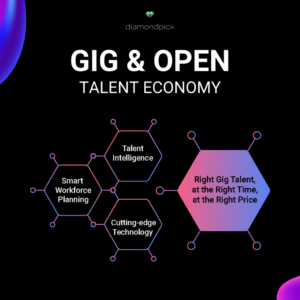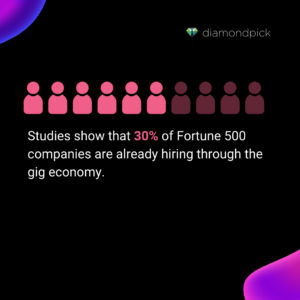In today’s dynamic job market, the gig economy is not a trend but a transformative force. With a growing number of professionals embracing flexible work arrangements, understanding the relevance of gig work in talent acquisition has never been more crucial. This blog delves into why the gig economy is reshaping the world of work and why talent acquisition leaders must adapt to these shifts.

Gig & Open Talent Economy
Employees will continue to push for more and more flexibility in the way they work in 2023, making a 9-5 workday a thing of the past.
Freelancers, independent contractors, part-time hires, project-based workers, online platform workers, temp workers, and contract on-demand workers – together form today’s ‘gig’ workforce.

As more and more individuals shift to independent work arrangements, this style of working is becoming mainstream. The boundless gig economy has potential for both professionals and employers alike. The most obvious appeal of hiring gig workers is that you can build a responsive workforce tailored to suit your business goals and objectives. You can quickly scale workforces to supplement in-house employees or quickly hire workers with niche skills needed to tackle specific jobs.
According to a Forbes study, regardless of gig economies’ current pace of adoption worldwide, it is here to stay, and it will strengthen into the future. It is projected that 80% of the workforce will be engaged in gigs by 2030.
The good news for recruiters is it opens up a wider talent pool to fill a job role – with the growing number of people open to short-term or dual contracts and faster hiring times. By creating a flex workforce plan, companies can bring in talent that was previously out of reach. In addition to building a larger talent pipeline, a flexible work environment can boost employee retention.
Talent acquisition leaders must redesign hiring strategies to attract and recruit talent from this gig market. Gig candidates are anything but conventional, and there will be a shift in candidate preferences like flexible schedules, output-oriented projects, self-managed leadership, and individual growth options. This seismic shift in the working models will require strong recruitment practices with stronger recruitment marketing strategies, building meaningful talent relationships, and harnessing the power of technology.

Telecommuting, job-sharing, flexitime, compressed work weeks, asynchronous working, and other such flexible work arrangements are becoming popular trends that employers need to offer to stay ahead of the recruiting game.
Another shift in the future of work is open talent ecosystems that look beyond corporate boundaries toward partners, vendors, and networks to integrate contractors, freelance talent, or even for crowdsourcing projects. Organizations must rethink the approach to sourcing talent to meet the greater agility and flexibility this model demands.
Recruitment practitioners must use a combination of cutting-edge workforce planning, talent intelligence, and technology to source the right talent at the right time and at the right price. Using tech-enabled platforms that leverage rich talent intelligence to match hiring demand to the right set of skilled job seekers according to their skills, location, etc.
A smart formula to hire right in today’s hybrid world of work:
Smart Workforce Planning + Talent Intelligence + Cutting Edge Technology = Right Gig Talent, at the Right Time, at the Right Price.
 As we head into a future where work will be all about fragmentation, where one gets paid by an employer for a bit of work or by many employers for lots of bits of work done. To make this way of working a success, we need a strategic tool to fragment work into components as per need, expertise, or time, and assign them efficiently. For example, why commit to a full-time systems engineer for a project when you can hire her/him for just six months? Or to fragment one big project for multiple gig workers to work on it simultaneously.
As we head into a future where work will be all about fragmentation, where one gets paid by an employer for a bit of work or by many employers for lots of bits of work done. To make this way of working a success, we need a strategic tool to fragment work into components as per need, expertise, or time, and assign them efficiently. For example, why commit to a full-time systems engineer for a project when you can hire her/him for just six months? Or to fragment one big project for multiple gig workers to work on it simultaneously.
Key Takeaways
Identify pain points in your current workforce scenario – do you need a specific niche skill set, or do you require an expert team – to better understand if the gig model works for you?
Engage gig workers to address pain points – quickly scale your workforce to supplement in-house employees or those with niche skills needed to tackle specific jobs.
Use tech-enabled platforms that leverage rich talent intelligence to match hiring demand to the right set of skilled job seekers according to their skills, location, etc.
Use a strategic tool to fragment work/tasks into components as per need, expertise, or time and assign them efficiently.

As the gig economy takes the spotlight in the future of work, it’s crucial to adapt and thrive. For more in-depth insights and actionable strategies, download our 2023 Talent Playbook. Prepare your organization for the gig workforce revolution and stay ahead in the evolving job market.
